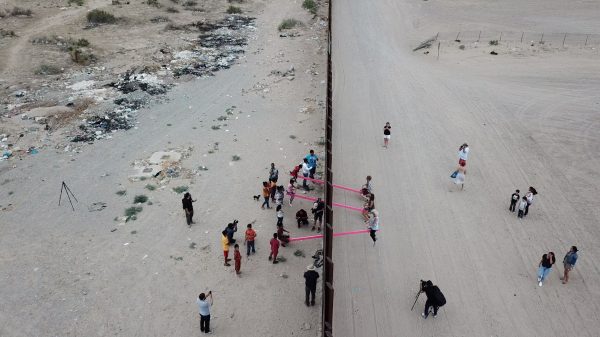‘Horrifyingly beautiful:’ An architect and designer turns his attention to borders and walls

Ronald Rael gained national attention this summer for installing teeter-totters through the U.S.-Mexico border fence, allowing children on either side to play, but the architect and designer has been studying borders, walls and their meaning for much longer.
Rael, based at UC Berkeley and principal at design studio Rael San Fratello, with partner Virginia San Fratello, is from an area in northern New Mexico and southern Colorado that once marked the northernmost extent of Mexico.
“Living through a territory of borders, one moves between different languages, different customs and cultures,” said Rael, the 2019 convocation speaker for the UNC Charlotte College of Arts + Architecture.

A child plays on the “Teeter-Totter Wall.” Courtesy Ronald Rael
Rael said the recent teeter-totter installation, on a section of border fence between New Mexico and Ciudad Juárez, was conceptualized a decade ago. It came about through past work he had done on the border, and his ongoing fascination with how we define the barriers that separate people.
“As a designer, my question is how do you respond to that to the phenomenon of a wall cutting through different places – farmlands, cities, private property, riparian zones,” said Rael. “It’s a very different scenario for the border to be defined by a river than for it to be fortified with a barrier.”
Putting a piece of playground equipment through the wall to allow children on either side of the border to play was a way of reimagining the wall’s purpose, Rael said.
“It has militaristic meanings, it has meanings related to violence and division,” he said. “The question was, what else can a wall do?”
President Donald Trump has spoken often about his planned border wall in terms of its design.
“We are not building a Concrete Wall, we are building artistically designed steel slats, so that you can easily see through it….It will be beautiful and, at the same time, give our Country the security that our citizens deserve,” he tweeted in December.
But Rael said questions of design and aesthetics aren’t how he thinks about the wall, even as an architect.
“I think the word beauty is subject to our own interpretation,” he said. “I actually think there’s something horrifyingly beautiful about the wall as it exist now.”

A conceptual sketch for “Teeter-Totter Wall.” Courtesy Ronald Rael.
Rael said he thinks that the pursuit of beauty as a goal in itself is bound to lead to ugliness.
“From my perspective, the worst kind of assignment you could ever give a design student is to say, ‘Design something beautiful.’ They will all bring in something ugly,” said Rael. “For Donald Trump to proclaim he’s going to make something beautiful guarantees, in my perspective, that he will create something ugly.”
Regardless of its physical form, Rael said the wall will function mostly as a symbol.
“That is something that people from all over the world can understand and want to act in support of or against,” he said. “It’s that act of symbology that will put people on one side or another. That is probably the greatest power of that wall.”
Rael is also interested in using new techniques like 3D printing and materials such as “upcycled” waste (Think sawdust and grape skins) and earth in construction. It’s a return to traditional methods of using locally available materials to craft structures, he said.
A 2018 project called “Cabin of Curiosities” created a livable, watertight structure entirely through the use of such materials and techniques.
“Probably the correct way to describe them is traditional materials,” he said. “They come from right there whether it’s timber or earth or stone. That was my tradition, and my understanding of how one makes buildings in the world.”